|
Sharing Our
Pathways
A newsletter of the Alaska Rural Systemic
Initiative
Alaska Federation of Natives / University
of Alaska / National Science Foundation
Volume 9, Issue 1, January/February 2004

In This Issue:

Education and Cultural Self-Determination
by Paul Ongtooguk, a son of Tommy
Ongtooguk, Presentation to the 2003 AFN Youth and Elders Convention
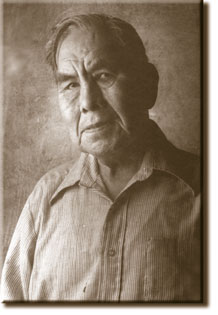
Tommy Ongtooguk
|
Thank you for the privilege of sharing in this
meeting in which we have all been gathered to consider the great
challenges facing us as Alaska Natives. The issue of this conference
of the Alaska Federation of Natives is central to the future
success of Alaska Native peoples.
Our very existence as distinct peoples within Alaska—the
very existence of our communities—rest on how we answer
the challenge of this conference: education and cultural self-determination.
For the last thirty years we have avoided the heart of the dilemma
about being Alaska Natives in this world at this time.
Our political leaders in the 1960s were caught
up in the conflicts and threats resulting from federal and state
governments and many other people taking Alaska Native lands — lands
and waters we had been living on for countless generations. We
accepted our life on these lands and waters as blessings with
enough hard challenges to press the very best efforts from us
as people. Many of the Elders here today are offering to share
with us all the lessons of our ancestors and what the land, the
waters and the animals have to share with us. The world is more
than money and there are lessons we can best learn as a part
of the world our cultures have grown up within.
Our schools were originally intended to break the
connection we had to our lands and waters and to break the spirit
within us that keeps us nurtured as Alaska Native peoples. Schools
tried to cut out of our minds our distinct understanding of the
world and our place within it. Schools tried to erase Alaska
Native cultures from the world. Most tragically, schools tried
to erase being Alaska Native from the hearts of our young people.
Fortunately for us and for the world, the heart of being Alaska
Native could not be erased. In many places our Elders and some
very tough parents ignored the falsehoods put forward in schools
about Alaska Natives being primitive or savage.
Our young people learned very different lessons
at home, at fish camps, at hunting camps, at potlatches, around
traditional feasts and during ceremonies. Some of our young learned
from the lessons of traditional dances and even from within the
folds of some culturally friendly churches.
Most of all our young people learned through the
lives of Elders who demonstrated the importance of giving to
the community as more important than gathering for oneself. The
best Elders taught with their lives the value of sharing as more
important than taking. The Elders also taught there was more
to life than others would have us learn. The lesson of developing
what one Elder, William Oquilluk, called the power of imagination
(www.alaskool.org) has been essential in allowing us to exist
and grow as Alaska Native peoples. We must learn again to imagine
more than what is taught in our schools and on TV. We must again
reject the lesson of ignorance about being Alaska Native.
The challenge of cultural self-determination
will not be won by the Native corporation with the biggest bank
account. A good future for the next generation of Alaska Natives
will not be established on winning some lawsuit. A political
win will not produce cultural victory. Success in business, in
politics and in the courts is important for Alaska Native people
to exist with dignity in this world today, but while these are
necessary they are not sufficient.
With the creation of Regional Education Attendance
Areas (REAAs) Alaska Native peoples won the promise of some measure
of self-determination and control over the education of rural
Alaska Native young people. This was a new and uncertain task
27 years ago as Alaska Native communities began to take over
our schools. We, as Alaska Native communities, were so happy
that our young people might not have to leave anymore to acquire
an education, we just wanted our young people to be as happy
as we were at simply being together.
For years many of our Alaska Native communities
had not experienced having young people living within our lives
all year round. In some ways we seem to have forgotten how to
help young people learn about their responsibility in contributing
to the community. I think some of us expected the expert teachers
to raise our young people as boarding home schools had raised
us. We live in the midst of this challenge today.
It's been 27 years since the REAAs were formed
and 37 years since the Alaska Federation of Natives was formed,
and finally the issue has been raised about Alaska Native education
and cultural self-determination. I think we can put this issue
into some direct questions for our communities, our schools,
our teachers and most importantly ourselves.
By the time our young people graduate from school
what will they be expected to know about our cultures? What will
Alaska Native young people learn about us? What should Alaska
Native young people learn about us? For schools and teachers
and communities that think they are doing pretty well on this
issue consider these questions:
-
How many of our Alaska Native high school graduates
will have read any—ANY—Alaska Native author?
Most current Alaska Native graduates will not have had a
single essay, speech, novel, short story, legend, oral history,
piece of poetry or anything written by an Alaska Native during
their 12 years of schooling.
-
How many Alaska Native young people can name
an Alaska Native leader and what that leader fought for on
our behalf?
-
How many Alaska Native young people know their
Alaska Native organizations and why they were created? Too
many of our young people are not being given the chance to
learn about us. The shame is not theirs—it belongs
to all of us.
As youth and Elder delegates you can stand up and
say this is wrong. We must reverse the direction of schools.
Schools and communities must come together and ensure the opportunity
to learn about our own history, Alaska Native leaders and oral
traditions that, in some cases, Alaska Native organizations have
spent millions of dollars preserving and yet the lessons of our
Elders still remain silent in most of our schools.
I think the Youth and Elders Convention should
ask the business and tribal delegates to address the theme of
this year's convention first before they get lost for another
year in the politics and money issues that so often preoccupy
them. We need commitment to change. I suggest a new resolution
asking the other delegates to begin answering the questions:
"What should Alaska Native young people learn
about us? What organizations, leaders, legends, poetry, stories,
oral history, political and social issues should we learn about
as young people? No professional educators can answer these questions
for us, nor should they. We, as Alaska Natives, together should
begin to ask and then answer the questions ourselves. We have
young people in Bethel who do not know who Jackson Lomack or
Chief Eddie Hoffman was. We have young people from the Interior
who do not know who Morris Thompson or Rosemarie Maher were.
We have young people from Southeast Alaska who do not know who
Elizabeth Peratrovitch was.
We need a resolution to ensure that education does
not come up every ten years or so but sits at the core as a central
focus of the Alaska Federation of Natives. In this regard I recommend
a resolution calling for a vice-president of education within
the Alaska Federation of Natives.
We need a resolution asking AFN to seek funding
to coordinate the learning opportunities of the Youth and Elder
Convention in ways similar to what Close-Up has done for
learning about federal and state issues.
We need a resolution coordinating what is taught
at cultural camps and after-school programs, changing what is
taught in schools and changing what teachers learn about Alaska
Natives.
There are many other parts of this issue
that must be addressed. We should have a resolution that supports
web sites as places to learn and share about our regional and
statewide cultures, organizations and issues. We need a resolution
to support Alaska Native young people who live outside the state
to learn about us. These young people who live outside the state
now number in the thousands. While they may be living out-of-state,
they have not left our hearts nor have they left the purpose
of the AFN Youth and Elders Convention.
We have too many young Alaska Natives who do not
feel nor do they learn any sense of connection to our Alaska
Native communities. We must ensure that our young people learn
key ideas about being Alaska Native, about our communities, about
our issues, about our challenges, about our leaders, about heroes,
about the tragic parts of our histories and about things for
which we can all be rightfully proud. This is not happening.
This must change.
Our Alaska Native young people must know that we
want them to learn about our rightful place in this world, about
the challenges we have faced as peoples and the opportunities
they will share. Most of all, our young people must know we care
about who they are as well as what they know. We must love and
respect our young people enough to share our greatest riches
with each one of them. We must share our heritage so they can
contribute to it, as well as to each other's and the world beyond.
Education and cultural self-determination are one and the same.

The Williwaw Way
by Matthew Dunckel, UAA PTEP Student
Every fall, just before school begins, the teachers
at Williwaw Elementary School spend an afternoon visiting each
of their new students at home. It is amazing what a home visit
by a teacher can do for the life of a student and their parents.
Welcoming a student and their family into the educational community
allows for a sense of belonging. A stronger bond exists between
children, their parents and a school community when all feel involved
and committed to the students' education.
Some parents view school as a place that people go
to loose their culture and language, but these home visits allow
the Williwaw staff to show parents that their childrens' culture
and first language will be embraced while at school.
Home visits have become a standard practice at Williwaw
Elementary for the last four years. Bonnie Goen, the principal
at Williwaw, believes these visits are becoming a tradition for
the staff and the students. "The more we know about our students
and where they come from, the better educators we become." Ms.
Goen feels so strongly about the home visits that she requires
them during the in-service days, prior to the first day of school.
She hopes that teachers will get a sense of their students outside
of the classroom and that the students will see their teachers
outside of the school setting. A teacher needs to be understood
as an educator and as a person, just as students need to be seen
as both students and individuals. "We gain empowerment through
cultural bonds." Ms. Goen adds, " . . . getting
out there and seeing where these students come from allows us to
see where we need to go as a class." To further the sense
of community, Williwaw plans a barbecue later the following day
for all students and their families. By embracing all languages
and cultures, a tone is set for positive educational interaction.
Williwaw notifies the parents the afternoon the teachers
will be visiting, and the day takes on a festive quality with children
running up and down sidewalks eager to see their new teacher arrive.
Students stop former teachers and talk openly about what they are
doing now and how they are enjoying their summer. Bonnie and her
staff understand that because of the varied cultural backgrounds
of the student body, a personal bond needs to emerge early with
the children and their parents. Due to the cultural make up of
the school community there are a large number of parents who do
not speak English, so their children are in the unique position
to act as translators. Even with this language barrier the home
visits have created a sense of unity. These interactions between
parents and educators foster an awareness that their childrens'
cultural identity will be accepted and not become an obstacle.
After the visits end the students of Williwaw are less apprehensive
about the first day of school. They come to school ready to learn.
Although home visits aren't standard in the Anchorage
School District, they are valuable. With expanding class size and
multiple ethnic groups represented, classrooms with the advantage
of home visits benefit substantially. Trust isn't given freely—it
must be earned—and home visits start that process before
the students ever leave for school.

Native American Songs as Literature
by Vivian Martindale
Utilizing the richness and variety of Native American
songs is one way to open up the world of Native American literature
in the classroom. After all, Native American cultures have a
rich oral tradition and many stories are told through the medium
of songs. Rhyme, rhythm, drums and dancing have the ability to
enhance the memory while simultaneously healing the spirit, mind
and body, providing for an enriching classroom experience.
Classrooms don't have to be boring. Literature
classes especially can be enhanced through the medium of song.
In David Leedom Shaul's article "A Hopi Song-Poem in Context",
he claims that the listener is similar to an audience during
storytelling, in that the listener is also interacting with the
music. The listener, as a participant, is not passive; the listener
is hearing rhythms, words, patterns and much more. The listener
does not have to understand the Native language in order to appreciate
the song. Shaul calls attention to the genre called "song
poems." These songs are in a category by themselves, separate
from poetry and prose. "The text of song-poems in Hopi culture,
like much poetry, seemingly create their own context by virtue
of minimalist language" (Shaul 1992:230-31). Therefore
it would be interesting to include the concept of song poems
or poetry as music into a curriculum.
Poet, songwriter and saxophonist, Joy Harjo, is
one such example of an artist/poet whose work could be shared
in a class on Native American literature. Other than being a
poet, Harjo is in her own band called Poetic Justice. Harjo is
from Oklahoma and is an enrolled member of the Creek Tribe. Her
work combines music with poetry. According to Harjo, "The
term poetic justice is a term of grace, expressing how justice
can appear in the world despite forces of confusion and destruction.
The band takes its name from this term because all of us have
worked for justice in our lives, through any means possible and
through music." Harjo's lyrics to her songs are a reflection
of her poetry, "a blending of rock, blues and prophecy" (Princeton
2003).
I include here an excerpt from Poetic Justices'
song "My House is the Red Earth," words and music by
Joy Harjo and John L. Williams:
My house is the red earth. It could be
the center of the world. I've heard New York, Tokyo or Paris
called the center of the world, but I say it is magnificently
humble. You could drive by and miss it. Radio waves can obscure
it. Words cannot construct it for there are some sounds left
to sacred wordless form. For instance, that fool crow picking
through trash near the corral, understands the center of the
world as greasy scraps of fat. Just ask him. He doesn't have
to say that the earth has turned scarlet through fierce belief,
after centuries of heartbreak and laughter (Poetic Justice
2003).
Poetic Justice is just one example of how contemporary
musicians use poetry to express issues facing Native Americans
today. Song poems, in themselves, hold a unique element of language
and culture.
In a more traditional manner, songs from around
Native America could be included, not just for listening enjoyment,
but also could include students' input on the lyrics; afterward
asking how the students thought the poet/artist expressed themselves
and how they felt when listening to the songs. Traditional singers
could be invited into the classroom to perform. But of course
permission to perform the songs and dances must be given by the
owners of the song so educators need to be aware that there is
an aspect of ownership as well as some songs and dances are only
to be performed at certain times of the year and by specific
persons. Usually dancing and other forms of expression accompany
songs. Students could be encouraged to close their eyes briefly
and afterward record what they heard as a participant compared
to what they saw as a participant. Also ask the students if they
felt as if they were participants on some other level or were
simply an observer or listener. In many of the contexts, songs
may not have to be translated if they are performed in their
Native languages. One can simply enjoy the language, how it sounds,
how it feels to the soul.
For further studies on Native American song poems
a good source is by author and editor Brian Swann called Song
of the Sky: Native American Songpoems. Although adding music
and song in a literary context may seem like a revolutionary
idea, Native Americans have been using songs to educate since
time immemorial. According to an article on the Alaska Native
Knowledge Network, "Singing and dancing were very important
to the Athabascan people. People often made up songs about events,
love songs, war songs or about relatives who had died for the
death potlatch. The children at potlatches and community events
observed the adults as a means to learn how to dance and sing.
Children learned to sing very early as it was very important
to the Athabascan way to carry on their teachings through oral
languages" (ANKN 2003). And yes, even college students enjoy
learning through the medium of music and song, especially when
it opens up the world of literature from other cultures.
Another resource for educators comes from Canyon
Records called Traditional Voices, which includes recordings
made in the 1950s and 60s. These rare songs were recorded by "historically
important singers from all over United States and Canada." This
collection offers a glimpse into the rich and varied tribal cultures
of twenty different Native American tribes. Samples from the
works include songs such as the Navajo " Yei-Be-Chai Chant," Northern
Cheyenne "Sun Dance Song," and the Tohono O'odham, "Song
Of The Green Rainbow." Through traditional songs and dances
this recording would be an excellent tool to introduce students
to Native American literary forms.
Songs or song poems, whether traditional or contemporary,
can be one instrument for educators to utilize in order to explore
various Native cultures. Involving local singers and dancers
is also important as well as any students who are willing to
share their songs and dances with their classmates. Dance and
songs are a means to understanding Native American cultures.
To appreciate other cultures, it is good to immerse ourselves
in each other's songs.
References
Alaska Native Knowledge Network. 2003. Athabascan
Winter Studies: The Dene' Indigenous Peoples of Interior Alaska.
Electronic document, http://ankn.uaf.edu/ANEunit/aneindex.html,
accessed July 14, 2003.
Harjo, Joy. 2003. Joy Harjo. Electronic document
http://www.princeton.edu/~naap/harjo.html, accessed July 14,
2003.
Harjo, Joy. 2003. KACTV Publishing/Muskogee.
Mekko Productions, Electronic document, http://www.joyharjo.com/index.html,
accessed July 14.
Shaul, David Leedom. 1992. "A Hopi Song
Poem in Context" In On the Translation of Native American
Literatures. Brian Swann ed. Washington: Smithsonian Insti-tution.
Traditional Voices. Electronic document, http://www.canyonrecords.com/cr7053.htm,
accessed July 14, 2003. Phoenix: Canyon Records.

Translations of Native American
Literature
by Vivian Martindale
"The fact that Indians were
human took some time to sink in.
The fact that their languages had value took longer."
—From On the Translations
of Native American Literature, ed. by Brian Swann
"The fact that Indians were human took some
time to sink in. The fact that their languages had value took
longer" From On the Translations of Native American Literature,
ed. by Brian Swann).
When offering translations of Native American texts
in the classroom, an educator ought to be aware of the background
of the translated material that is offered. The written text
is simply not enough as discussions must include information
about the author if available, background information about the
culture and demographics, information about the translator and,
most importantly, the implications of translation from oral traditions
to the written form. Only then can an educator offer an honest
examination of the Native American text.
Brian Swann's On the Translation of Native American
Literatures is one such resource for educators. Published in
1992 by the Smithsonian Institution, this book is divided into
four sections. The book opens with a brief introduction by Swann,
followed by a second section providing an overview of the translation
of Native American literature. In section three, Swann organizes
the contributing essays by language and geography. Finally, section
four concerns itself with the translations of Central and South
American Indian literature.
When offering translated texts in the classroom
an educator must consider a very important point: "The very
problematic relationship between the academics who study this
material and become its interpreters to American society at large,
and the people who live in it" (Swann 1992). One should
realize that the Western worldview provides a different context
for interpreting material that is originally performed in a Native
American context. The translator, considered the author (especially
in older published texts), is often Euro-American. So therefore
when reading poetry or songs from as far back as the early seventeenth
century through the 1800s and early 1900s, no value was placed
upon accurate translation of Native literature. In the essay "Tokens
of Literary Faculty" by William M. Clements, he claims translating
the songs, poems and oratory of Native Americans was done simply
to control them and ultimately eliminate their culture.
Clements strongly stresses the opinions of the
times: "The songs, stories and orations of the Indians had
so little literary merit that they deserved the same fate as
the cultures in general. Since they could be consigned to oblivion
with no esthetic loss, translating them served at most the purposes
of those who sought to understand Native Americans for the sake
of efficiently subjugating them."
When translated, oral traditions were written to
fit the popular forms of poetry and songs of the times. Euro-American
translators thought there was an infancy in the language that
would eventually mature with the Natives becoming civilized (Clements
1992:35-37). Therefore, offering students who study and appreciate
Native American literature these thoughts could profoundly change
how they interpret the material.
These reasons could account for the stereotypes
and prejudices about Native Americans that evolved into our American
culture. For example, from books and other literature we read
about the stoic Indian, the savage, the vanishing Indian, the
child-like Indian and the drunken Indian. All are images that
began with translators who came from a different worldview than
the Native peoples themselves. This insight, however, should
not dissuade the educator from offering older texts in the classroom
or other valuable interpretations of Native literature by non-Natives,
but the educator should definitely discuss with students the
background of the translator and the views of the times. Also
discussed should be how much time the translator spent in the
community and what, if any, knowledge the translator had about
the community or people. The question should also be asked "Does
the translator have a reliable person from the Native community
who they consulted on the translated material?"
For many Euro-American translators the goal is
to be aesthetically pleasing to the market for which the translator
is working. In regions where the languages are non-existent and
the translator only has anthro-pologist's and ethnologist's documents
to work from, with no local speakers available, the translator
is in danger of taking excessive creative license. Fortunately
in Alaska there are Native language speakers still available
for consultation.
The culture and demographics of the material being
examined is also important. Since reading literature from a particular
culture is an excellent way to learn about that culture, it would
be valuable if students looked up terms they didn't understand
and were presented with an overview of the culture. Items to
consider are the location of the community and a bit of historical
perspective about the region from which the literature comes.
For example, if one would be studying Velma Wallis' Two Old Women,
it would enhance the readers experience if they knew where Velma
lived and where the story took place. In Wallis' case, she is
an Alaska Native and she herself is the translator of the story
from the oral tradition to the written form. Wallis also used
some creative license to re-tell the story for publication with
editing help from others. In this case, Wallis' book is probably
a more accurate style of the retelling of an oral tradition than
many earlier works in Alaska that were done by non-Natives (Wallis
1993).
Lastly, the implications of translating an oral
tradition into the written form must be considered when exploring
Native American literature in the classroom. Many older literary
works from the 1800s aren't up to modern standards of translative
criteria (Clements 1992). A good technique to introduce into
the classroom would be to invite a Native American orator to
tell a story using the oral traditions prior to the students
reading a written version and then, at another time, have them
read the story first prior to hearing and watching it performed.
Knowing the difference and identifying the possible places where
interpretation could differ is a valuable lesson when reading
material that is based upon oral traditions.
An educator must be aware when offering material
that are translations from oral traditions that not all translators
come from the same worldview as the Native peoples they are writing
about. But despite this, Native American literature, whether
a translation or by the original author, offers wonderful ways
to explore the beauty and uniqueness of America's numerous Native
American cultures.
References
Swann, Brian, ed. 1992 On the Translation of Native
American Literatures Washington: Smithsonian Institution.
Wallis, Velma. 1993 Two Old Women: An Alaskan Legend
of Betrayal, Courage and Survival. New York: Harper Collins.
Clements, William. 1992 "Tokens of Literary
Faculty," In On the Translation of Native American Literatures.
Washington: Smithsonian Institution.

Native Educator's Conference and
BMEEC Merge for 2004
The annual Native Educator's Conference (NEC) and
Bilingual-Multicultural Education and Equity Conference (BMEEC)
will be held at the Anchorage Sheraton February 10-14, 2004.
Registration information and a preliminary event schedule can be
viewed at: ankn.uaf.edu/bmeec.
NEC will be held concurrently with the BMEEC, with
NEC workshops running as a special strand focusing on culturally-responsive
strategies for education in Alaska. A strong set of panelists and
workshop presenters from throughout Alaska will provide a stimulating
look at what schools and communities are doing to implement the
Alaska Standards for Culturally Responsive Schools.
The first day of activities will consist of pre-conference
work sessions where all are invited to join in. The morning session
will focus on finalizing plans for the re-establishment of a statewide
Alaska Native Education Association to assist with the efforts
of the regional Native educator associations that have been formed
over the past ten years. In addition to adopting a set of by-laws
and electing officers, discussions will be held regarding potential
projects for which the new ANEA can seek funding, including support
for sponsoring regional cultural orientation programs.
The afternoon session will address performance criteria
for the establishment of a cross-cultural specialist endorsement
that will be presented to the State Board of Education for approval
to be implemented in a manner similar to the current reading and
special education endorsements associated with a state teaching
certificate. We encourage everyone to attend the work sessions
and participate in shaping these initiatives.
In the evening of February 10, we will host the annual
Honoring Alaska's Indigenous Literature awards ceremony and reception
at Josephine's on the top floor of the Sheraton. Everyone is invited
to join in this event recognizing people from each region who have
contributed to the rich literary traditions of Alaska Natives.

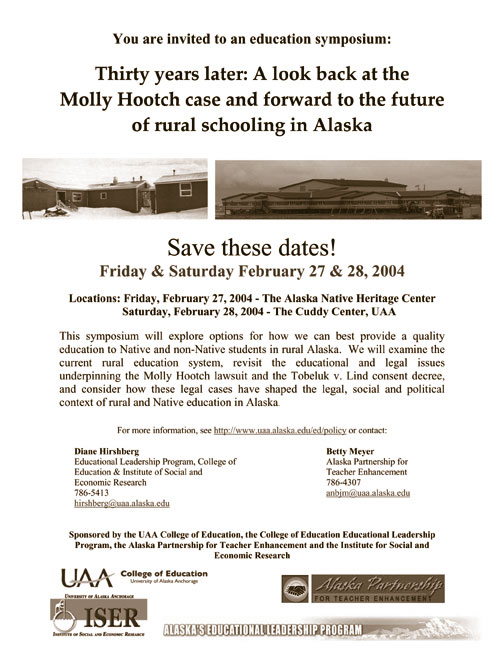

ANKN Curriculum Corner: Forests
for the Future
by Dawn Wiseman, dawn@encs.concordia.ca
Forests for the Future is a research project run
out of University of British Columbia (UBC) that is focused on
integrating local ecological knowledge with natural resource
management. Working with members of the Tsimshian people, the
Forests of the Future team has developed seven curriculum units.
The key focus of these materials has been inspired
by the experiences of students and community members living within
the Tsimshian territory of the province of British Columbia.
The extension material in this package include curriculum material
designed for use in the Province of British Columbia's K-12
education system. In addition, the material can be easily adapted
to function as reference resources for community members and
other interested resource stakeholders.
Unit 1: Two Ways of Knowing, Traditional Ecological
Knowledge Meets Western Science
Unit 2: Traditional Plant Knowledge of the Tsimshian
Unit 3: First Nations Resource Use on the Northwest
Coast: Investigations into Geography, Ecology, Knowledge and
Resource Management
Unit 4: Tsimshian Involvement in the Forest Sector
Unit 5: A Sense of Place: Regional Identity,
Informal Economy and Resource Management
Unit 6: Oona River. The River People: Living
and Working in Oona River
Unit 7: Traditional Ecological Knowledge and
Ecosystem Sustainability: Guidelines for Natural Resource Management.
Units are in PDF format and require Adobe Acrobat
Reader (a free download) for viewing and download.
The units can be found at: http://www.ecoknow.ca/activities.html.

 Athabascan
Region: Youth Environmental Group Visits Old Minto Athabascan
Region: Youth Environmental Group Visits Old Minto
by Nicholette Sauro, Alaska Youth
For Environmental Action
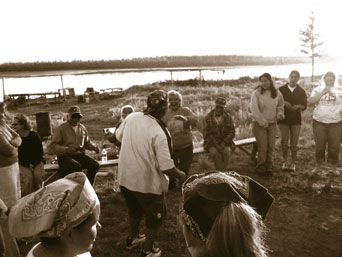
Minto Elders show campers how to dance.
|
It was our last night at Old Minto and the last rays
of the sunset were still reaching out for us with their orange
glow. The whole camp gathered in a circle with Elders and distant
relatives teaching us their traditional dances. Beating on plastic
bowls with spoons for a beat, everyone joined in clapping and bringing
their own style to the circle.
Elders Suzie Charlie and Sarah and Berkman Silas
lit up when teaching three guys the Raven dance, where the men
stretch out the arms and circle around an object representing food. "Now
get it, pick it up," they said. All three guys at once tried
picking it up at the same time with their mouth while still keeping
their balance which is almost impossible. The sight would make
anyone laugh. The dancing continued late into the night until everyone
was exhausted from dancing and laughing so hard.
This event was part of the fourth annual Alaska Youth
for Environmental Action (AYEA) Summer Get Together (SGT) held
in Fairbanks August 4-10, 2003. AYEA is a non-profit organization
run through the National Wildlife Federation. The SGT is a one-week
educational field trip held at a different place in Alaska each
year. Thirty students from all around Alaska—urban, rural,
Native and non-Native—were invited. This year we had students
from Anchorage, Saint Marys, Healy, Juneau, Naknek, Fairbanks,
Fort Yukon, Homer, Point Baker, Point Lay, Russian Mission, Kenai
and Dillingham. With this broad range of students, you would think
we would have trouble getting along but to my surprise, it was
much the opposite. Every student had unique ideas to bring to the
table which was important when we were discussing such issues as
subsistence and local issues that affected Alaska. Not to mention
there was always something to talk about.
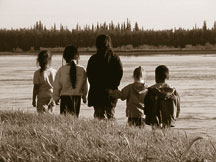
A reflective time watching the river.
|
At the SGT we picked a topic that we feel is of concern
to Alaska that we can focus our energy on for the upcoming year.
This year we chose the topic of trophy hunting which affects many
people in rural Alaska. Our concern is that a lot of meat is being
wasted when hunters simply take the hide or head of an animal and
leave all the meat or body to rot. A smaller group of AYEA students
meet periodically throughout the year to discuss the issue and
steps we have to take. We hope to have it resolved by the end of
the school year.
Besides singing and dancing at Old Minto we made
mini birch-bark canoes to take home. Elders Susie and Sarah led
the ladies into the woods and showed us how to score birch trees
and slowly peel away the outer bark in big sheets. To sew the bark
into a canoe, we needed the root of spruce trees which we also
learned how to identify, dig up, peel and split. It doesn't sound
like much, but was a long delicate process. It took me six hours
to finish mine and about 30 minutes for Sarah to finish. I found
myself out of breath trying to keep up with 76-year-old Susie as
we tried to find a tree with thick bark. I was amazed about how
healthy and young-looking the Elders were. In the Athabascan culture,
Elders are looked up to and respected for their wisdom. They are
taken in by their families instead of being seen as a burden.
Overall, the SGT was an unforgettable, once-in-a-lifetime
experience. I have a better understanding of Alaska Native culture
and the environment and learned how to be a leader while building
confidence and hanging out with an awesome group of people, all
at the same time!
Learning Styles Grant Summary
by Bob Maguire
The Association of Interior Native Educators (AINE)
recently received a three-year grant from the U.S. DOE to fund
the establishment of a Learning Styles Center to train teachers
in both the Fairbanks North Star Borough School District and the
Yukon-Koyukuk School District.
National research on the effect of learning styles-based
teaching has demonstrated that this style of teaching can produce
a dramatic increase in student achievement and learning. The training
of classroom teachers in how to assess individual students learning
styles and, more importantly, how to set up classroom learning
environments and develop teaching strategies based on learning
styles is very exciting for Interior Alaska school districts.
In the AINE Learning Styles grant there will be three "partner
teachers" hired to serve as trainers and mentors for other
teachers within the two districts. The FNSBSD will have two partner
teachers and the YKSD will have one.
During the first year of the grant, AINE will advertise
and hire one position within YKSD and one position within the FNSBSD.
The timeline for hire is second semester of the 2003-04 school
year (January-May). These partner teachers will reside in Fairbanks
and receive Learning Styles training as well as observing and working
in a model Learning Styles classroom in Fairbanks. They will also
be extensively involved in the planning of the 2004 Summer Institute
on Learning Styles for teachers.
Beginning with the second year of the grant, the
partner teachers will mentor and work with both the YKSD and FNSBSD
teaching staffs on site in their various classroom locations.
In addition, the AINE Learning Styles Center grant
will contain a curriculum development strand. This will allow for
the continuation of culturally-relevant curriculum through the
Project AIPA model based on the concept of an Elders academy bringing
together certified Native teachers and selected Elders in a camp
setting. The certified teachers then develop curriculum units based
on their experiences.
The potential for educational change throughout these
two Interior school districts through the Learning Styles concept
is extremely exciting.
Anyone wishing further information regarding this
new grant can contact Sheila Vent, Learning Styles Center project
secretary at (907) 459-2141 or by e-mail: vents@doyon.com.

 Iñupiaq
Region: Discovery, Native Science After-School Activites Iñupiaq
Region: Discovery, Native Science After-School Activites
by Katie Bourdon
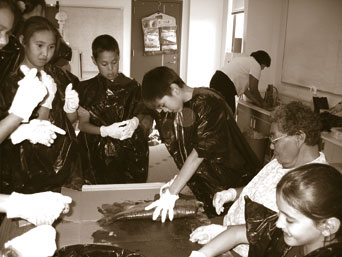
Elder Esther Bourdon sitting on the right and Zachary Bourdon cutting
fish to hang. Watching from left to right are Maggie Ahkvaluk,
Cody Sherman and Rachel Pomrenke in the front.
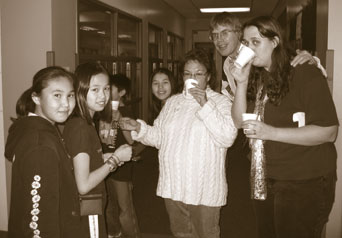
L to R: Maggie Ahkvaluk, Darla Swann, Emma Outwater; teachers Josie
Bourdon, Joel Bachelder and Jenny Bachelder. Teachers Miss Bourdon
and Mrs. Bachelder both picked the campfire coffee.
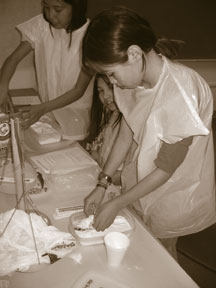
Darla Swann packs tomcod with baking soda to begin the mummifying
process.
|
|
Kawerak's Eskimo Heritage Program has recently
begun an after-school activity for fourth through sixth graders
in Nome called "Discovery" or "Native Science".
Our small group has six devoted young scientists who come every
Thursday for one hour to learn together. Experiments involve
using materials, food or animals that are common in our community
such as tomcods, salmon, homemade bread and coffee.
Paula Herzner and Katie Bourdon, EHP staff, have
been using Alan Dick's Village Science and the Alaska Native
Knowledge Network website as resources for class ideas. Barbara
Pungowiyi, Nome Public Schools Native Programs Director, has
provided Native science fair exhibits from her junior high and
high school students. These exhibits have served as examples
for the young students in the Discovery class.
Elder Esther Bourdon joined the group on the first
day to talk about harvesting salmon and the various ways to preserve
it. The students were willing and eager to begin cutting fish
for hanging, smoking and salting. An experiment was done on frozen
fish, dry fish and fish left out at room temperature for a few
days. The youth learned about bacteria, the importance of weather
and keeping blow flies away and about surface area.
Recently, the kids did an experiment with coffee.
Local Elder Frank Okleasik regularly gets his tea water from
Glacier Creek and donated the creek water for an experiment.
The kids made percolated "campfire" coffee using the
Glacier Creek water. Filtered coffee was also made using regular
tap water. The students went around to 6 different teachers to
find out which coffee was preferred. "Old-timers say that
campfire coffee is the best" (Alan Dick's Village Science).
Students hypothesized about the outcome of the experiment; most
guessed that three out of six would know the difference. Zachary
Bourdon's hypothesis was correct: five out of six preferred the
campfire coffee. The students had fun making the coffee, presenting
their experiment to the teachers and documenting their results.
Another fun (and in the kids' words, "cool")
activity was mummifying tomcods. Paula Herzner's family had fished
for the tomcods prior to class so the students were able to gut
them in class, weigh them and document their observations of
the fish before the mummifying process. Loads of baking soda
filled and encapsulated the tomcods. The following week, the
students again weighed and documented their findings. They cleaned
out the old baking soda and repacked the tomcods with enthusiasm.
After two weeks of dehydrating, the results were mummified tomcods!
We want to share our experience to encourage other
communities to have their own after-school Native science class.
The resources are available, as long as there are volunteers
in your community who are willing to plan and work with the youth.
Please contact Kawerak Eskimo Heritage Program
at (907) 443-4386 or at ehp.pd@kawerak.org for more information
about having your own Native Science after-school activities.
Visit the Alaska Native Knowledge Network at www.ankn.uaf.edu
for class ideas and activities and to find Alan Dick's Village
Science. Go Native Science!
Editors Note:
Village Science by Alan Dick, is available online
at ankn.uaf.edu/VS. An interactive version for the computer
is also available online or on CD free-of-charge from the ANKN
offices.
Inupiaq Region: Annie Blue, Elicarai—Her
Teachings
by Yaayuk Alvanna
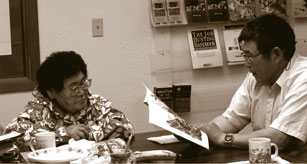
Elder Annie Blue sitting with John Mark, a retired Yup'ik principal
from the village of Quinhagak.
|
Always teaching
Always learning
An Elder speaks
While listeners
observe intently Learning from brain to heart
Lessons given
Lessons learned
Through oral speech
Knowledge passed
Knowledge gained
Through listening carefully
Stories told
Stories hold
Such treasured wisdom
That can only be passed
From an Elder to younger ones
In the Native language
Quiet settles as she speaks
A world created
In the minds
Of each individual
Always learning
Always teaching
—yaayuk alvanna

 Southeast
Region: The Southeast Alaska Tribal Resource Atlas Southeast
Region: The Southeast Alaska Tribal Resource Atlas
by Andy Hope
The Southeast Alaska Tribal Resource Atlas is an
ongoing project that has many components and has been several years
in the making. Beginning in January 2004, presentations of the
atlas will be made to tribes, Elders, clan and clan house leaders,
educators and other interested parties. These presentations will
continue throughout the winter and spring of 2003-2004. Each
of these respective individuals, groups and organizations will
be requested to endorse publication of the atlas for educational
purposes. The atlas has been developed in the noble traditions
of reciprocity, sharing of knowledge and generosity. Here are some
of the components of the atlas:
The Southeast Alaska Native Place
Name Project
In 1994 the Southeast Native Subsistence Commission
(SENSC) initiated a three-part project to document Native place
names in Southeast Alaska. The project has been funded largely
through the National Park Service Heritage Preservation Fund grant
program, with additional support from Native, state and federal
entities and covers all of Southeast Alaska's Native communities
from Yakutat to Hydaburg.
The Southeast Alaska Tribal Electronic
Mapping Project
This project started in the summer of 2002. The purpose
of the project is development of place-based education materials
for educators.
Objective: Provide GIS maps and technical support
to facilitate access to the Southeast Alaska Native Placenames
Database, including integration with existing data on subsistence
use areas, development of regional and community-based maps for
use in classrooms, internet mapping and other place-based education
activities.
The Angoon, Kake and Sitka Cultural
Atlases
The ANKN web site contains the Angoon and Kake cultural
atlases. These links require a user name and password that can
be obtained at ankn.uaf.edu/oral.html. The Sitka Atlas is accessible
at: www.sitkatribe.org/placenames
Space precludes a complete acknowledgement of those
that contributed to development of these atlases in this article.
Such acknowledgements are included in above-referenced links.
The Traditional Tlingit Country and
Tribes Map
The Traditional Tlingit Country Map/Poster was the
culmination of more than 25 years of research. It was initially
published in draft form in 1997. There have been four printings
of 1,000 since 1998. I began compiling a list of Tlingit tribes,
clans and clan houses in 1972. Initially, this list was part of
a manuscript on Tlingit clan and clan house at.—ow, or crests.
At.—ow translates "our belongings or possessions".
ankn.uaf.edu/TlingitMap/index.html
The Herman Kitka Traditional Ecological
Knowledge Series
This is a collection of 13 CD-ROMs originally recorded
in winter 1996 at UAS Juneau as part of Anthropology 354, Culture
and Ecology, co-taught by Professor Thomas F. Thornton and Herman
Kitka, Sr. The CD-ROMs were produced and edited by Arlo Midgett,
UAS Media Services and Thomas F. Thornton under a grant from the
Alaska Rural Systemic Initiative, with additional support from
the Sitka Borough School District and the Sitka Tribe of Alaska.
The series is cross-indexed category, topic, format, disc number
and by clip. ankn.uaf.edu/tek.html
The Place-Based Education Resources
for Southeast Alaska Educators Web Site
The goal of this project is to provide Alaska educators
with access to online and print resources to assist them in creating
place-based curriculum for Alaska schools. This site includes the
I Am Salmon curriculum project materials. Of particular interest
are the "Aakwtaatseen/Alive in the Eddy" materials. These
materials will be added to the Place-Based Education Resources
web site in January 2004. This material is based on a story told
by Deikeenáak'w of the Kookhittaan in Sitka in 1904 and
transcribed by John R. Swanton in 1904 and published in Wanton,
Tlingit Myths and Texts (1909) as Story #99. The story was transliterated
into modern orthography by Roby Littlefield and Ethel Makinen.
The material was edited by Roby Littlefield, Ethel Makinen, Lydia
George, Nora Marks Dauenhauer and Richard Dauenhauer. This site
can be found at: http://pec.jun.alaska-edu:1680/salmon
The Tlingit Elders Traditional Education
Checklist
The Tlingit Elders Traditional Education Checklist
was originally published by Tlingit Readers in 1976 in the appendix
of Beginning Tlingit. Beginning Tlingit. It has been reprinted
a number of times, most recently in 2003 by Sealaska Heritage Institute
(SHI). The checklist was originally published in the 1991 SHI edition.
Among the contributors to the checklist are the following Tlingit
Elders and educators: Jessie Dalton, Katherine Mills, David Kadashan
and Henry Davis—T'akdeintaan of Xunaa Kwáan; George
Davis—Deisheetaan of Xutsnoowœ Kwáan; Forrest
DeWitt—L'eeneid’ of Aak'w Kwáan; Walter "Babe" Williams—Chookaneidi
of Xunaa Kwáan; Walter Soboleff—L'eeneid’ of
Xutsnoowœ Kwáan and Austin Hammond—Lukaax.ádi
of Jilkoot Kwáan. The draft reflects feedback and input
received from Tlingit Elders. It is difficult or impossible to
know everything on the list. Probably no single Elder knew all
of it. The checklist was endorsed by the Southeast Alaska Tribal
College Elders Council in October 2001 and by the SEATC Board of
Trustees in the spring of 2002. The checklist will be published
in poster form in a joint venture with SEATC Elders and Trustees
and the Southeast Alaska Native Educator Association in January
2004.

 Unanga{
Region Unanga{
Region
Values poster now available from
the ANKN offices!
*In order to view the above text
correctly, you will need to install the Unangam-Tunuu font on
your computer. Available at: Alaskools
website.
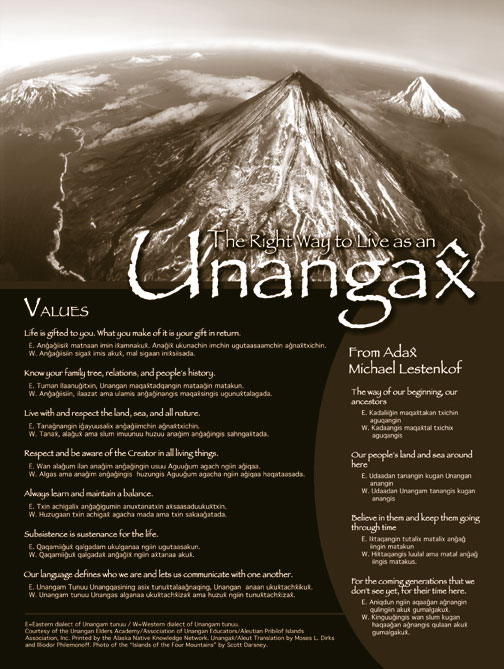
Unanga{ Language
and Culture*
by Qagidax Moses L. Dirks, Unangan
Language and Culture Teacher, Unalaska City School District.
The Unangan Language and Culture students in Unalaska
have been working on reproducing traditional Unangan artifacts.
As part of the program the students had the opportunity to do hands-on
type of projects. One of the first projects the students worked
on was carving of an Aleut mask. All mask carvings were based on
what was found in historical texts and pictures. Once the students
started carving they did a good job in portraying what an Unangan
mask might look like. Here are some of the students' work and what
they had to say:
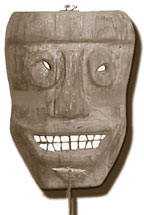 Maqulaasi}ulux Maqulaasi}ulux
by Garrett Pletnikoff
This
mask is Maqulaasi}ulux which means “no
reason to be an idol.” It is made out of basswood,
which isn’t traditional material. If it were a traditional
mask it would have different facial expressions, it would
have a hat and it would not have such white teeth. Way
back, a long time ago, the Unangan would use driftwood
such as yellow cedar. They used this wood because it has
less knots so it is a lot easier to work with. The Unangan
used stone adzes and bones to make the masks, well, a thousand
years ago the Unangan did this.
The
paint I used was a red ochre and flat white. The red
ochre was used in
the time of war so it is basically war-paint, but I just
got a can of red paint; do you know how they got red
a thousand years ago? First they would collect ochre
rocks and they would grind the red ochre into fine dust,
and then oil was mixed and red paint was made. I used
the white paint for the teeth. I also have an untraditional “labret,” which
means he is a man. The bigger the labret the higher the
person’s social-class in the village. |
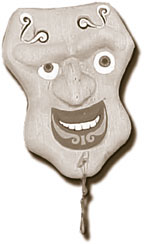 Ayagam
Taya}uu Ayagam
Taya}uu
by Alberto Oropeza
This mask is named Ayagam Taya}uu, which
means, ladies man in Unangax. The mask is made out of basswood.
All of the decorations are painted on with acrylic paint
and have some sort of meaning. For example, on the Ayagam
Taya}uu mask there is an item on the chin called the iqlu{,
which determined where an Unanga{ came from and what their
status was in the village. Also, the colors used to paint
this mask are very common in other things, like bent wood
hats, spears and spear throwers.
Masks where used by the Unangan for ceremonial
and feasting purposes, but after Christianity was introduced
by the Russian Orthodox church priests, they did not want
the Unangan to have masks because they believed that they
attracted evil or bad things. The Unangan decided that
masks where bad based on the newly formed religion, and
that is when masks were abolished.
Presently masks are being brought back by
the Unangan people and replicas are being made of what
we think they may have looked like in the past, but that
is a long ways to the real intent of the Unangam Sagimaaqluu. |
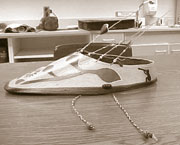 Chuguda{ Chuguda{
by Jon Nichols
After I bent my hat I then painted it. I
got most of my designs for my hat from Glory Remembered,
a book on the wooden headgear of Alaska sea hunters. The
main Aleut traditional design on my hat is a design created
by Andrew Gronholdt. The sea lion whiskers tied to the
top of the visor represented how successful the hunter
was, and the longer the whiskers the better the hunter.
To paint the hat, I used acrylic paint so that it would
last a long time. I used only traditional Aleut colors
to keep it in line with the culture. The colors are turquoise,
black, and red ochre. After all the painting was done I
then layered the hat with a clear varnish to preserve it
even longer and make the paintings on it stand out more.
Then I tied duck feathers to the sea lion whiskers with
sinew for decoration and also to show that the person who
wore it was a duck hunter. |
*In order to view the above text
correctly, you will need to install the Unangam-Tunuu font on
your computer. Available at: Alaskools
website.

 Yup'ik
Region: Cultural Accuracy in Curriculum Yup'ik
Region: Cultural Accuracy in Curriculum
by Esther A. Ilutsik
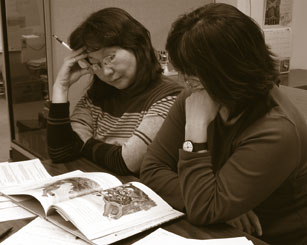
Nita Reardon and Esther Ilutsik at the first meeting of the Yup'ik Literary
Review Board held in Dillingham October 24-27, 2003.
|
It dawned on me when I was listening to the frustrations
of Elder Annie Blue of Togiak as she was reacting to a non-Native
authors' account of some of the beliefs of the Yup'ik people that
there is this illusion of a common language. Before writing this "historical
fiction," the non-Native author had done extensive research
of ethnographic reports by anthropologists who came into the Yup'ik
region and documented their observations and findings in the 1890s.
Simply put, it was the ignorance and ethnocentric attitudes that
intervened as researchers strove " . . . to
get a perspective beyond one's own nation, to see some sort of
whole instead of the defensive little patch offered by one's own
culture, literature and history" (from Changing Traditions
in Northern Ethnography, by Julie Cruikshank, 1994).
Apparently, the complications of language did not
enter the minds of those academics whose goal it was to publish
works that were only understood from the Western perspective.
Language in itself is not only for communication,
but to organize one's thinking, to direct reason and analyze nature
(from Language, Experience and Illusion, by Prof. K.V.K. Nehru).
I have been trying to understand how those ethnographers in the
late 1800s were able to document traditional Yup'ik knowledge and
have it recorded and published within such a short time frame,
which seems like such an unrealistic endeavor, especially if one
understands how hard it is to translate humor from the Yup'ik context
into the Western context. The humor can easily be lost in translation
because it is retained within the context of the culture, where " the
fact of the matter is that the 'real world' is to a large extent
unconsciously built up on the language habits of the group" (from
Language, Experience and Illusion, by Prof. K.V.K. Nehru, who cites
Whorf and his teacher Edward Sapir.) Likewise, we have the same
problem with the historical context of the Western educational
system (since the late 1800s) and the on-going efforts at "educating" the
indigenous people utilizing the English language, even though the
results have continued to disappoint those who utilize assessment
tools that are generic to the Western-based culture.
So I can begin to understand the frustrations that
Elder Annie Blue shared as we reviewed examples of childrens' literature,
much of it written by non-Natives. The information presented was
too often an unrealistic and inaccurate portrayal of the Yup'ik
people. The same problem continues today with professional educators
who are asked to write curriculum addressing the cultural context.
It is important therefore, that Native authors and educators take
a more active role in documenting traditional knowledge and helping
to prepare curriculum materials that reflect a strong understanding
of cultural ties and most importantly the language and local knowledge
base.

Alaska RSI Contacts
Co-Directors
Ray Barnhardt
University of Alaska Fairbanks
ANKN/ARSI
PO Box 756730
Fairbanks, AK 99775-6730
(907) 474-1902 phone
(907) 474-5208 fax
email: ffrjb@uaf.edu
Oscar Kawagley
University of Alaska Fairbanks
ANKN/ARSI
PO Box 756730
Fairbanks, AK 99775-6730
(907) 474-5403 phone
(907) 474-5208 fax
email: rfok@uaf.edu
Frank W. Hill
Alaska Federation of Natives
1577 C Street, Suite 300
Anchorage, AK 99501
(907) 263-9876 phone
(907) 263-9869 fax
email: fnfwh@uad.edu |
Regional Coordinators
Alutiiq/Unangax Region
Olga Pestrikoff, Moses Dirks &
Teri Schneider
Kodiak Island Borough School District
722 Mill Bay Road
Kodiak, Alaska 99615
907-486-9276
E-mail: tschneider@kodiak.k12.ak.us
Athabascan Region
pending at Tanana Chiefs Conference
Iñupiaq Region
Katie Bourdon
Eskimo Heritage Program Director
Kawerak, Inc.
PO Box 948
Nome, AK 99762
(907) 443-4386
(907) 443-4452 fax
ehp.pd@kawerak.org
Southeast Region
Andy Hope
8128 Pinewood Drive
Juneau, Alaska 99801
907-790-4406
E-mail: andy@ankn.uaf.edu
Yup’ik Region
John Angaiak
AVCP
PO Box 219
Bethel, AK 99559
E-mail: john_angaiak@avcp.org
907-543 7423
907-543-2776 fax |
Lead Teachers
Southeast
Angela Lunda
lundag@gci.net
Alutiiq/Unangax
Teri Schneider/Olga Pestrikoff/Moses Dirks
tschneider@kodiak.k12.ak.us
Yup'ik/Cup'ik
Esther Ilutsik
fneai@uaf.edu
Iñupiaq
Bernadette Yaayuk Alvanna-Stimpfle
yalvanna@netscape.net
Interior/Athabascan
Linda Green
linda@ankn.uaf.edu |
is a publication of the Alaska Rural Systemic
Initiative, funded by the National Science Foundation Division
of Educational Systemic Reform in agreement with the Alaska
Federation of Natives and the University of Alaska.
This material is based upon work supported
by the National Science Foundation under Grant No. 0086194.
Any opinions, findings, and conclusions or recommendations
expressed in this material are those of the author(s) and
do not necessarily reflect the views of the National Science
Foundation.
We welcome your comments and suggestions and encourage
you to submit them to:
The Alaska Native Knowledge Network
Old University Park School, Room 158
University of Alaska Fairbanks
P.O. Box 756730
Fairbanks, AK 99775-6730
(907) 474-1902 phone
(907) 474-1957 fax
Newsletter
Editor
Layout & Design: Paula
Elmes
 Up
to the contents Up
to the contents
|